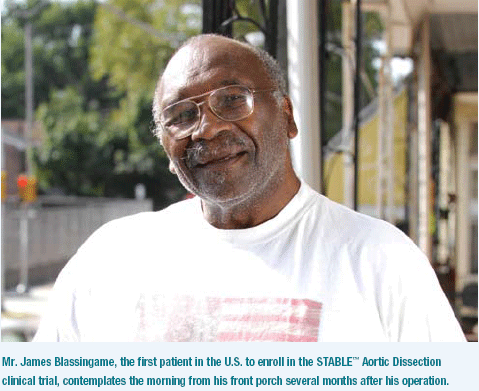
Recommended Citation
(2008)
"First U.S. Patient Enrolls in Groundbreaking Clinical Trial at Jefferson,"
Jefferson Surgical Solutions: Vol. 3:
Iss.
2, Article 1.
Available at:
https://jdc.jefferson.edu/jss/vol3/iss2/1
When James Blassingame, 79 and his wife returned home from church one Sunday, he bent down and could not stand back up, doubled over in pain. He was rushed to a local hospital, where Joseph Lombardi, MD, director of the new Jefferson Aortic Center and Associate Professor of Surgery was called for consultation. Dr. Lombardi diagnosed Mr. Blassingame with a Type B dissection of his thoracic aorta.

Mr. Blassingame was transferred to the Thomas Jefferson University Hospital for surgery where he became the first patient in the U.S. to enroll in the STABLETM Aortic Dissection clinical trial. "The STABLE trial is an important milestone in the development of novel, minimally invasive treatments for thoracic aortic dissections," explains Dr. Lombardi, who is global Principal Investigator (PI) of the study.
The STABLETM trial is an important milestone in the development of novel, minimally invasive treatments for thoracic aortic dissections.
Mr. Blassingame, a retired staffing specialist for the federal government, is grandfather to 18 grandchildren and seven great grandchildren. "At my age, I was concerned about having any kind of surgery," he recalls. "I thought I could just do without it, especially knowing that open surgery could be fatal. But my daughter, who is a licensed nurse practitioner, explained how important and non-invasive this surgery was, and how it would really help to reduce the risks of complications or worse." Performing Mr. Blassingame's surgery with Dr. Lombardi was Robert A. Larson, MD, Assistant Professor of Surgery, who serves as the site PI for the STABLETM trial. This trial and other new programs at Jefferson led to the expansion and renaming of the Division of Vascular and Endovascular Surgery.
Endovascular surgery directs therapy through catheters and wires placed within the blood vessels. The stents hold open the wall of the weakened vessel, and the endovascular grafts - fabric tubes used to make a new path for the blood to flow - are placed inside the vessel. This minimally invasive method spares patients the trauma and risk of open surgery, decreases recovery time, and improves quality of life following the procedure.
The STABLETM trial will significantly help treat a condition that affects tens of thousands of people just like James every year," says Dr. Lombardi. "This truly is a remarkable, lifesaving advancement."
For more information about endovascular surgery visit: www.jeffersonhospital.org/aortic
The Surgeons Speak
James Blassingame was a perfect candidate for participation in the STABLETM Aortic Dissection clinical trial. Given the combination of his age, medical history, and what we were able to learn from our pre-surgical vascular mapping, we knew that we could successfully treat him with the Cook ZenithTM Dissection Endovascular System. The technology we now have enables us to treat patients like James in a way that radically reduces risks and decreases the recovery period.
In Mr. Blassingame's case, our three-dimensional TerRecon workstation was critical in determining if he was anatomically sutiable for endovascular surgery. We used the 3D imaging to measrue the size of the vessel and to determine how much to treat. It is the ultimate planning tool - enabling you to visualize the procedure, select the right devices, and see in advance exactly where the weakened vessel begins and ends. Once planned, the operation was performed with state of the art equipment in our new endovascular operating suite.
--Joseph V. Lombardi, MD, and Robert A. Larson, MD
